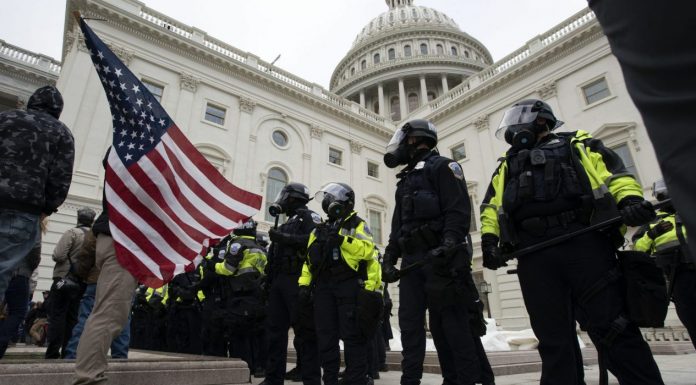(Mark Pellin, Headline USA) Already reeling from public disclosures of J6 videos that showed allegedly violent insurrectionists strolling like tourists through the Capitol, the Biden administration’s Justice Department is refusing to release more than 8,000 hours of security camera footage covering the hours from noon to 8 p.m. on Jan. 6, 2021.
Protesters who have been criminally charged for their alleged J6 activity claim that the video footage being wrongly held hostage by the DOJ could include exculpatory evidence crucial to their cases.
William A. Pope of Topeka, Kansas, has been waging a legal battle with the DOJ to gain access to the hidden video. Pope was slapped with eight federal charges for allegedly interfering with a law enforcement officer and impeding passage inside the Capitol building, along with obstructing congressional proceedings and unlawfully entering a restricted area, the Epoch Times reported.
Pope has consistently denied the charges and claimed he was peacefully protesting at the Capitol, which he said video footage could help prove. Capitol Police told federal investigators that Pope was memorable from Jan. 6 because of his “large size and his passive resistance,” when he allegedly blocked officers from closing a door.
“I was at the Capitol to exercise my First Amendment rights and remain loyal to the United States of America,” Pope told the Topeka Capital-Journal in February 2021. Pope claimed he was never violent and said he reported his actions to the FBI after the protests erupted into an isolated riot because “it was the right thing to do.”
Now the same FBI, Pope said, is denying him access to video that could help his case, as well as others.
In a court filing earlier this week, Pope wrote that the DOJ has provided J6 defendants access to less the 40% of available video footage.
Pope’s court filing sought to “compel the government to inventory and produce all Capitol Police CCTV footage. This is an issue because the government has previously withheld highly relevant CCTV cameras from discovery, only to announce later that they had suddenly discovered more cameras in their possession.”
Pope wrote that DOJ’s claims that they “inadvertently omitted” some cameras and only “recently identified” others “are not credible, especially since they have produced only 650 total cameras in discovery, yet I have seen more than 1,700 cameras in the congressional access terminals with my own eyes.”
DOJ’s alleged lack of a full inventory of all Capitol Police CCTV was particularly disturbing, Pope said.
“If the government does not even know what they have, the government is likely denying hundreds of January 6 defendants important exculpatory evidence,” Pope wrote.
“This would be like the government sending an innocent man to death row because they were too lazy to test for the DNA that would exonerate him,” Pope admonished in the court filing. “This potential for depriving citizens of their liberties without due process makes it even more crucial for this court to compel the government to inventory all Capitol Police CCTV in their possession, and to produce it in discovery.”
Pope’s previous attempts to gain access to J6 footage led to his finding “that claims made by the government (claims that there were no undercover government provocateurs at the Capitol on January 6) were false,” he wrote in a February court filing.
“One of those exhibits (a video clip of an undercover MPD officer who was joining the crowd in chants of ‘Drain the swamp!’ and ‘Whose house? Our house!’ and repeatedly urging protestors to advance up the northwest steps to the Capitol) could not be shared publicly because the government has designated it as ‘sensitive’ and hidden it under seal.”
The DOJ has steadfastly opposed Pope’s motions for additional discovery.

